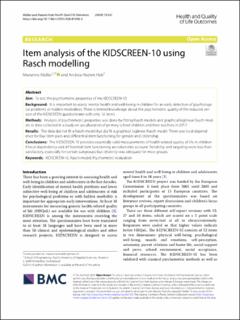Please use this identifier to cite or link to this item:
https://doi.org/10.21256/zhaw-20674| Publication type: | Article in scientific journal |
| Type of review: | Peer review (publication) |
| Title: | Item analysis of the KIDSCREEN-10 using Rasch modelling |
| Authors: | Müller, Marianne Haenni Hoti, Andrea |
| et. al: | No |
| DOI: | 10.1186/s12955-020-01596-6 10.21256/zhaw-20674 |
| Published in: | Health and Quality of Life Outcomes |
| Volume(Issue): | 18 |
| Issue: | 1 |
| Page(s): | 342 |
| Pages to: | 384 |
| Issue Date: | Oct-2020 |
| Publisher / Ed. Institution: | BioMed Central |
| ISSN: | 1477-7525 |
| Language: | English |
| Subjects: | KIDSCREEN-10; Psychometric evaluation; Rasch model |
| Subject (DDC): | 155: Differential and developmental psychology |
| Abstract: | Aim: To test the psychometric properties of the KIDSCREEN-10. Background: It is important to assess mental health and well-being in children for an early detection of psychological problems or hidden morbidities. There is limited knowledge about the psychometric quality of the reduced version of the KIDSCREEN questionnaire with only 10 items. Methods: Analysis of psychometric properties was done by fitting Rasch models and graphical loglinear Rasch models to data collected in a study on acculturation of primary school children and their teachers in 2017. Results: The data did not fit a Rasch model but did fit a graphical loglinear Rasch model. There was local dependence for four item pairs and differential item functioning for gender and citizenship. Conclusions: The KIDSCREEN-10 provides essentially valid measurements of health-related quality of life in children if local dependency and dif ferential item functioning are taken into account. Reliability and targeting were less than satisfactory, especially for certain subgroups but reliability was adequate for most groups. |
| URI: | https://digitalcollection.zhaw.ch/handle/11475/20674 |
| Fulltext version: | Published version |
| License (according to publishing contract): | CC BY 4.0: Attribution 4.0 International |
| Departement: | School of Engineering |
| Organisational Unit: | Institute of Data Analysis and Process Design (IDP) |
| Appears in collections: | Publikationen School of Engineering |
Files in This Item:
| File | Description | Size | Format | |
|---|---|---|---|---|
| 2020_Müller_Item_analysis_of_the_Kidscreen-10_Health_and_Quality_of_Life_Outcomes.pdf | 814.88 kB | Adobe PDF |  View/Open |
Show full item record
Müller, M., & Haenni Hoti, A. (2020). Item analysis of the KIDSCREEN-10 using Rasch modelling. Health and Quality of Life Outcomes, 18(1), 342–384. https://doi.org/10.1186/s12955-020-01596-6
Müller, M. and Haenni Hoti, A. (2020) ‘Item analysis of the KIDSCREEN-10 using Rasch modelling’, Health and Quality of Life Outcomes, 18(1), pp. 342–384. Available at: https://doi.org/10.1186/s12955-020-01596-6.
M. Müller and A. Haenni Hoti, “Item analysis of the KIDSCREEN-10 using Rasch modelling,” Health and Quality of Life Outcomes, vol. 18, no. 1, pp. 342–384, Oct. 2020, doi: 10.1186/s12955-020-01596-6.
MÜLLER, Marianne und Andrea HAENNI HOTI, 2020. Item analysis of the KIDSCREEN-10 using Rasch modelling. Health and Quality of Life Outcomes. Oktober 2020. Bd. 18, Nr. 1, S. 342–384. DOI 10.1186/s12955-020-01596-6
Müller, Marianne, and Andrea Haenni Hoti. 2020. “Item Analysis of the KIDSCREEN-10 Using Rasch Modelling.” Health and Quality of Life Outcomes 18 (1): 342–84. https://doi.org/10.1186/s12955-020-01596-6.
Müller, Marianne, and Andrea Haenni Hoti. “Item Analysis of the KIDSCREEN-10 Using Rasch Modelling.” Health and Quality of Life Outcomes, vol. 18, no. 1, Oct. 2020, pp. 342–84, https://doi.org/10.1186/s12955-020-01596-6.
Items in DSpace are protected by copyright, with all rights reserved, unless otherwise indicated.